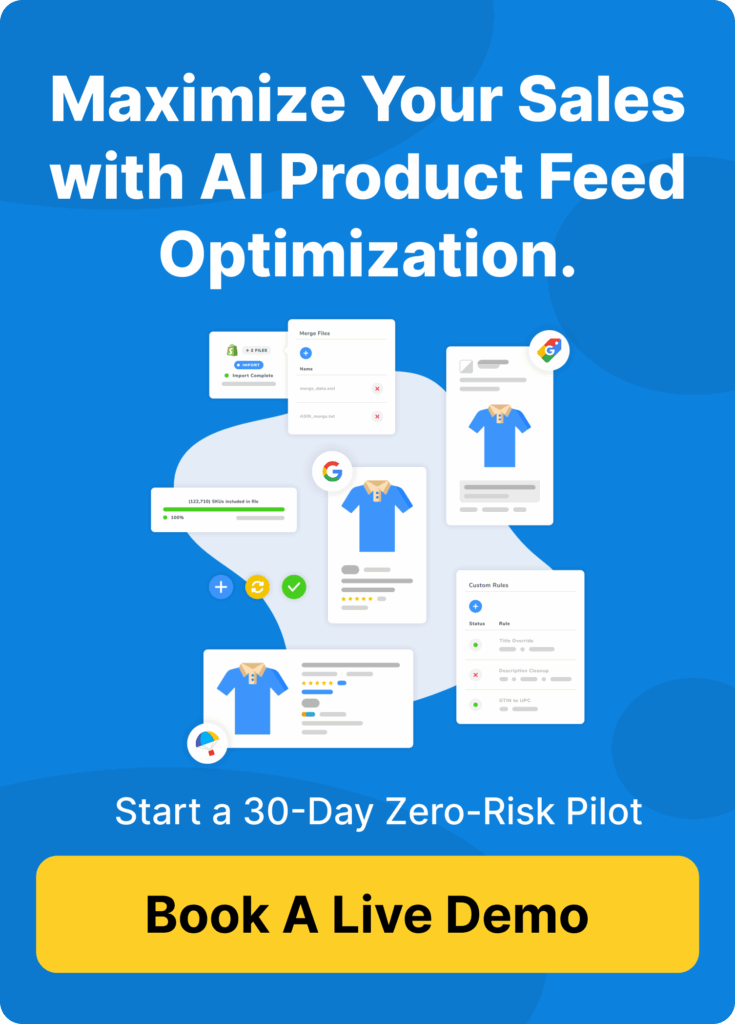Shopping Feed Management actively optimizes and manages a product catalog, promoting products across multiple online shopping channels like Google and Bing Shopping. This process demands continuous management of product data feeds, encompassing product information such as title, description, images, price, and availability.
There are three main stages in shopping feed management.
- Firstly, connection involves getting your products into the shopping channel through Google or Bing Merchant Center. This connection is your shopping feed.
- Secondly, policy compliance plays a crucial role. Both Google and Bing enforce rules, and if your product data fails to comply, your products simply won’t appear.
- Finally, optimization offers the opportunity to outshine competitors and secure sales by improving your ranking.
Jump to section
Connecting is a great first step towards successful shopping feed management
To enhance product visibility and advertise, connect your product data to a shopping channel’s Merchant Center. The Merchant Center transfers crucial product details like prices, images, and other attributes. This aids in managing and improving product content while initiating shopping feed management.
To display shopping ads to potential customers looking for similar products, upload your products to the relevant Merchant Center. This process ensures your products appear in Google and Bing search results, attracting your target audience and increasing traffic and sales.
Ensure your product data complies with the shopping channel’s requirements for proper display. If your data doesn’t comply, edit it to ensure proper formatting and inclusion of all necessary attributes. Proceed with advertising if your website data meets these requirements.
Fixing policy violations is essential.
Both Google and Bing Merchant Centers have rules to ensure that advertisers maintain high quality and honesty, and provide a good experience for customers and advertisers. Advertisers must obey these rules to use the Merchant Centers and advertise their products on these shopping platforms.
The rules cover a wide range of issues, such as data quality, product data accuracy, and product safety. It is important to provide correct and up-to-date product information, use appropriate language and pictures, and obey relevant laws and regulations.
By obeying these rules, advertisers can enjoy several benefits. First, they can keep using both Google’s and Bing’s Shopping platforms and reach potential customers. Also, following the rules helps build trust with customers, as they know they can trust the products they see and buy are safe.
Moreover, following the rules can help advertisers improve ad performance. Both Google’s and Bing’s systems consider data quality and accuracy when choosing which ads to show, so ads that obey the rules are more likely to be seen by potential customers.
Put simply, obeying Merchant Center rules is important to maximize growth and stay visible on both Google’s and Bing’s Shopping platforms.
Optimization of shopping feeds for growth
Optimizing your shopping feed, a part of shopping feed management, fine-tunes product data quality, accuracy, and relevance. By doing so, you can attract more customers and increase sales. Here’s how:
Better visibility in search results: Accurate and detailed product information makes it easier for search engines to display your products in search results. Improved click-through rates: Relevant and precise product data increases the chances of potential customers clicking on your ads. Higher conversion rates: Detailed product information gives customers the confidence to complete a purchase. Better targeting: Specific attributes like size, color, or price range help target products to interested customers.
Shopping feed management is a powerful process. By providing search engines and potential customers with accurate, relevant, and detailed product information, you can improve your visibility, click-through rates, conversion rates, and targeting, ultimately driving more traffic and revenue to your business. Increasing sales is the goal of shopping feed management
How to edit your product data feed
- Access your shopping data feed: Log in to your Merchant Center account and navigate to the “Products” tab. From there, you can access your product data feed.
- Identify the product(s) you want to edit: Use the search and filter options to find the product(s) you want to edit. You can search by product ID, title, or any other relevant attribute.
- Make the necessary changes: Once you’ve identified the product(s) you want to edit, click on the product ID to view its details. From there, you can make changes to any of the available data attributes, such as title, description, price, or image.
- Save your changes: After making your changes, be sure to save them before exiting the product details page. You can save changes to individual products or multiple products at once.
- Monitor your feed for errors: Once you’ve made your edits, monitor your feed for any errors or warnings. These could indicate issues with your data quality, which may affect the performance of your ads.
- Re-upload your feed: Once you’ve made your edits and resolved any errors or warnings, you can re-upload your product data feed to Merchant Center.
How often should you check your shopping feed?
Keep in mind that shopping data feeds need to be updated regularly to ensure that your product information is accurate and up-to-date. By following these steps and regularly updating your product data feed, you can ensure that your ads are displaying accurate and relevant information to potential customers, leading to higher engagement and sales.
Learn more about FeedOps. Find out how you can optimize your product data for better advertising returns
Explain it to a 5 Year Old!
So, you know how when we want to buy something online, like a toy or a shirt, we have to look at pictures and read about it before we buy it? Well, the people who sell those things online have to make sure the pictures and words are really good, so that more people will want to buy their things.
And sometimes, they use a special tool called a “shopping feed management” to help them do a really good job with the pictures and words. This tool helps them show their things to more people and helps people find the things they want to buy easier.
So, if the people selling things online use this tool to make their pictures and words better, then more people will buy their things and they can be really successful at selling things online.

Explain a Shopping Feed Management to a 12 year old!
This article is about a service called “Shopping Feed Management.” This service helps sellers who want to sell their products online. It does this by managing the information that they give to websites like Google Shopping or Amazon.
The article explains that with Shopping Feed Management, sellers can make sure that their products show up in more places online. This means that more people will be able to find and buy their products. The service can also help sellers manage their inventory (how many of each product they have available), pricing, and other important details about their products.
So, in short, Shopping Feed Management is a service that helps sellers sell their products online. It does this by managing the information they provide to websites like Google Shopping or Amazon. This can help them reach more customers and make more sales.


